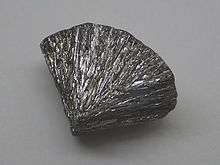The periodic table/Tellurium
< The periodic table| |
Subject classification: this is a chemistry resource . |
| |
Completion status: this resource is just getting off the ground. Please feel welcome to help! |
| |
Educational level: this is a research resource. |
| |
Resource type: this resource is an article. |

Tellurium (abbreviated "Te"), from the latin word for "Earth" (tellus), is a metalloid in the Oxygen Family.
Discovery
Tellurium was discovered by Franz-Joseph Müller von Reichenstein, an Austro-Hungarian Mineralogist and mining engineer, living in the Habsburg Empire in 1782. Reichenstein purified a substance from a Transylvanian gold ore (which is actually gold telluride, AuTe2, often known as calaverite), in which he believed he was handling antimony (another element). He published his discoveries of the element in a journal. The whole research was forgotten.
M. Klaproth, another scientist, was sent the work by Reichenstein... and isolated the element in 1789. He named it "tellurium", and gave full credit for element of Tellurium to Reichenstein.
Quick Facts
Name: Tellurium Symbol: Te Mass: 127.6 Classification: Oxygen Family Discoverer: Franz-Joseph Müller von Reichenstein Protons: 52 Neutrons: 76 Electrons: 52 |
Protons: 52 Electrons: 52 Neutrons: 76 Color: silvery Discovered in: 1782 Melting point: 449.51°C Boiling point: 988°C |
External Links
This element is a stub. Learn how you can help Wikiversity to expand it. (See other stubs here)